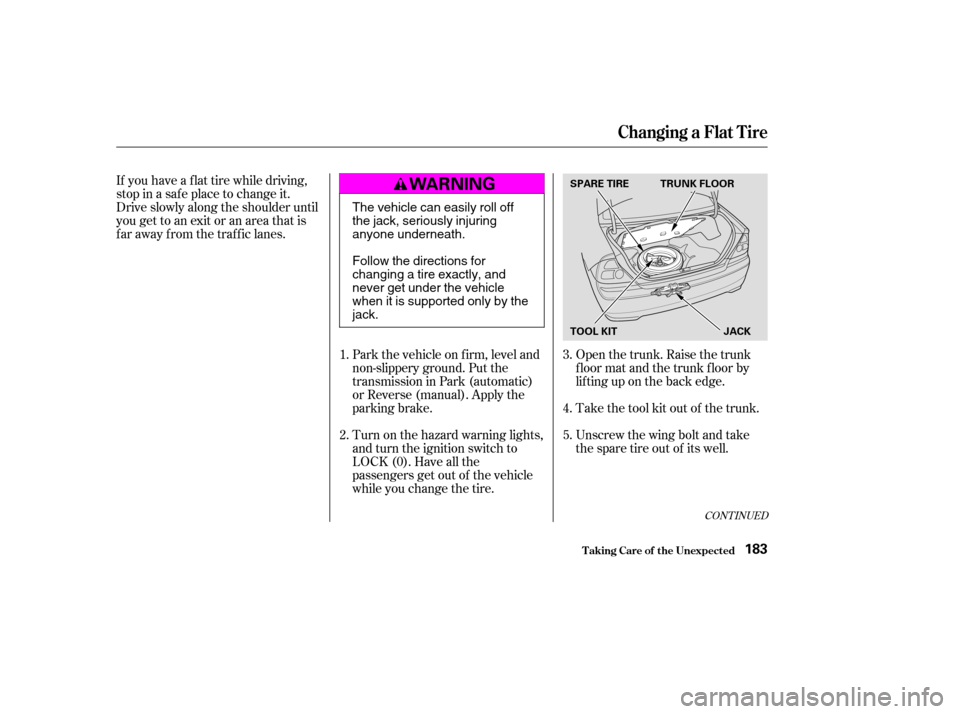Page 125 of 231
Fasten your seat belt. Check that
your passengers have f astened
their seat belts (see page ).
When you start the engine, check
the gauges and indicator lights in
the instrument panel (see page).
Make sure the doors are securely
closed and locked.
Check the steering wheel
adjustment (see page ).
Check the adjustment of the
inside and outside mirrors (see
page ).
Check that any items you may be
carrying are stored properly or
f astened down securely.
Check the seat adjustment (see
page ).
Youshoulddothefollowingchecks
and adjustments every day bef ore
you drive your vehicle.
Make sure all windows, mirrors,
and outside lights are clean and
unobstructed. Remove f rost, snow,
or ice.
Check that the hood and trunk are
f ully closed.
Visually check the tires. If a tire
looks low, use a gauge to check its
pressure.
1. 2. 3. 4.
9.
8.
7.
6.
5.
10.
76
83 68 14
53
Driving
Preparing to Drive
126
�����—�����—�����y�
�������������y���
�(���%�������y���
�����y
Page 136 of 231

Always use the parking brake when
you park your vehicle. Make sure
the parking brake is set f irmly or
your vehicle may roll if it is on an
incline.Make sure the moonroof and the
windows are closed.
Turn of f the lights.
Place any packages, valuables, etc.
in the trunk or take them with you.
Lock the doors.
If your vehicle has an automatic
transmission, set the parking brake
bef ore you put the transmission in
Park. This keeps the vehicle f rom
moving and putting pressure on the
parking mechanism in the
transmission.
Never park over dry leaves, tall
grass, or other f lammable
materials. The hot three way
catalytic converter could cause
these materials to catch on fire.If the vehicle is f acing uphill, turn
the f ront wheels away f rom the
curb. If you have a manual
transmission, put it in f irst gear.
If the vehicle is f acing downhill,
turn the front wheels toward the
curb. If you have a manual
transmission, put it in reverse gear.
Make sure the parking brake is
f ully released bef ore driving away.
Driving with the parking brake
partially set can overheat or
damage the rear brakes.
Driving
Parking T ips
Parking
137
�����—�����—�����y�
�������������y���
�(���%�������y���
�����y
Page 163 of 231
Theheadlightswereproperlyaimed
when your vehicle was new. If you
regularly carry heavy items in the
trunk, readjustment may be required.
Adjustments should be perf ormed by
a Honda dealer or other qualif ied
mechanic.Your vehicle has halogen headlight
bulb. Handle it by its steel base and
protect the glass f rom contact with
your skin or hard objects. If you
touch the glass, clean it with
denaturedalcoholandacleancloth.
NOTE: Halogen headlight bulbs get
very hot when lit. Oil, perspiration,
or a scratch on the glass can cause
the bulb to overheat and shatter.
If you need to change the
headlight bulb on the driver’s side,
remove the power steering
reservoir tank by pulling it out of
its holder.
1.
Lights
Maint enance
Headlight A iming Replacing a Headlight Bulb
164
HOLDER
�����—�����—�����y�
�����������
�y���
�(���%�������y���
�����y
Page 166 of 231
Open the trunk.
Remove the screw in the center of
the f astener on the side of the trunk
lining. Pull the lining back. Determine which of the three
bulbs is burned out: stop/taillight,
back-up light or turn signal light.
Remove the socket by turning it
one-quarter turn counterclockwise.Pull the bulb straight out of its
socket.
Push the new bulb straight into
the socket until it bottoms.
Testthelightstomakesurethe
new bulb is working.
Reinstall the socket into the light
assembly by turning it clockwise
until it locks.
Reinstall the trunk lining. Make
sure it is installed under the edge
of the trunk seal.
Put the f astener into the hole on
the side of the trunk lining.
Reinstall the screw.
1.
2. 3.4. 5. 6. 7. 8.
Lights
Maint enance
Replacing Rear Bulbs
167
FASTENER
BULBS
BULB SOCKET
SOCKETS
�����—�����—�����y�
���������
���y���
�(���%�������y���
�����y
Page 167 of 231
Open the trunk and remove the
socket f rom the light assembly by
turning it one-quarter turn counter-
clockwise.Reinstall the socket. Turn it
clockwise until it locks. Make sure
the new bulb is working.
Pull the bulb straight out of its
socket.
Push the new bulb straight into
the socket until it bottoms. 3.
2.
1.
Lights
Maint enance
Replacing a High-mount Brake
Light Bulb
168
SOCKET
BULB
�����—�����—�����y�
���������
���y���
�(���%�������y���
���
�y
Page 178 of 231

If you need to park your vehicle f or
an extended period (more than one
month), there are several things you
should do to prepare it f or storage.
Proper preparation helps prevent
deterioration and makes it easier to
get your vehicle back on the road. If
possible, store your vehicle indoors.Fill the f uel tank.
Change the engine oil and f ilter. Block the rear wheels.
If the vehicle is to be stored f or a
longer period, it should be
supported on jackstands so the
tires are of f the ground.
Leave one window open slightly (if
the car is being stored indoors).
Disconnect the battery.
Support the f ront wiper blade
arms with a f olded towel or rag so
they do not touch the windshield.
To minimize sticking, apply a
silicone spray lubricant to all door
and trunk seals. Also, apply a
vehiclebodywaxtothepainted
surfaces that mate with the door
and trunk seals.
Wash and dry the exterior
completely.
Cleantheinterior.Makesurethe
carpeting, floor mats, etc. are
completely dry.
Leave the parking brake off. Put
the transmission in Reverse
(5-speed manual) or Park
(automatic). Cover the vehicle with a
‘‘breathable’’ cover, one made
f rom a porous material such as
cotton. Non-porous materials, such
as plastic sheeting, trap moisture,
which can damage the paint.
If possible, run the engine f or a
while periodically until it reaches
full operating temperature (the
cooling f an cycle on and of f twice).
Pref erably once a month.
If you store your vehicle f or 12
months or longer, have your Honda
dealer perf orm the inspections called
f or in the 24 months/30,000 miles
maintenance schedule (Normal
Conditions) as soon as you take it
out of storage (see page ). The
replacements called f or in the
maintenance schedule are not
needed unless the vehicle has
actually reached that time or mileage. 145
Vehicle Storage
Maint enance179
�����—�����—�����y�
�������������y���
�(���%�������y���
�����y
Page 182 of 231

Park the vehicle on f irm, level and
non-slippery ground. Put the
transmission in Park (automatic)
or Reverse (manual). Apply the
parking brake.
Turn on the hazard warning lights,
and turn the ignition switch to
LOCK (0). Have all the
passengers get out of the vehicle
while you change the tire.Take the tool kit out of the trunk.
Unscrew the wing bolt and take
the spare tire out of its well.
Open the trunk. Raise the trunk
f loor mat and the trunk f loor by
lif ting up on the back edge.
If you have a f lat tire while driving,
stop in a saf e place to change it.
Drive slowly along the shoulder until
you get to an exit or an area that is
far away from the traffic lanes.
5.
4.
3.
2.
1.
CONT INUED
Changing a Flat T ire
T aking Care of t he Unexpect ed183
SPARE TIRE TRUNK FLOOR
TOOL KIT JACK
The vehicle can easily roll off
the jack, seriously injuring
anyone underneath.
Follow the directions for
changing a tire exactly, and
never get under the vehicle
when it is supported only by thejack.
�����—�����—�����y�
�������������y���
�(���%�������y���
�����y
Page 186 of 231
Tighten the wheel nuts securely in
the same crisscross pattern. Have
the wheel nut torque checked at
the nearest automotive service
f acility.
Tighten the wheel nuts to:Remove the center cap before
storing the f lat tire in the trunk
well.Place the flat tire face down in the
spare tire well.
Remove the spacer cone f rom the
wing bolt, turn it over, and put it
back on the bolt.
Secure the f lat tire by screwing
the wing bolt back into its hole.
15. 16. 17.
18. 19.
CONT INUED
On HX and EX models in the U.S., Simodel in Canada
Changing a Flat T ire
T aking Care of t he Unexpect ed187
WING BOLT SPACER CONE
80 lbf·ft (108 N·m , 11 kgf·m)
�����—�����—�����y�
�������������y���
�(���%�������y���
�����y